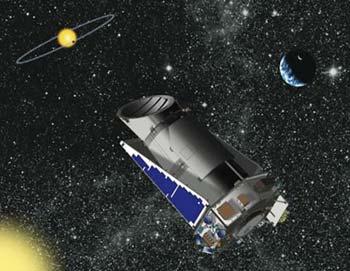Source: Xinhua
03-09-2009 10:57
Special Report: Tech MaxLOS ANGELES, March 6 (Xinhua) -- NASA's Jet Propulsion Laboratory (JPL) announced on Friday that the Kepler spacecraft is scheduled to be launched on a mission intended to probe deep space for Earth-like planets that could harbor life.
 |
| An artist's conception of the Kepler spacecraft. (NASA Photo) |
The 600-million-U.S.-dollar spacecraft is slated to blast off from Florida's Cape Canaveral Air Force Station Friday night at 10:49 p.m. EST (0349 GMT), according to JPL which is based in Pasadena of Los Angeles.
The craft -- carrying a 0.95-meter-in-diameter telescope called a photometer -- will be ferried aloft by a Delta II rocket, said JPL which is managing the mission.
When fully operational in a couple of months, the craft will embark on a 3 1/2-year mission, during which it will scan more than 100,000 stars, JPL said.
Astronomers will monitor stars ranging from the smaller, coolerones -- whose planets orbit closer to them -- to the larger and hotter stars, whose planets must orbit farther away to survive, JPL said.
Kepler's telescope has "a very large field of view" comparable in size to the back of a hand held at arm's length, and this field of view will allow scientists to simultaneously monitor the brightness of more than 100,000 stars for the duration of the mission, JPL said.
With data provided by Kepler, scientists will search for planets believed to be in "habitable zones," regions where pools of surface water are possible, according to JPL.
Liquid water is considered essential for the formation of life.
Finding extrasolar planets is a daunting task because light from the stars they orbit swamps the reflected light of the satellites, according to the JPL.
"Trying to detect Jupiter-size planets crossing in front of their stars is like trying to measure the effect of a mosquito flying by a car's headlight," said James Fanson, Kepler project manager. "Finding Earth-sized planets is like trying to detect a very tiny flea in that same headlight."
Using Kepler's powerful photometer and camera, scientists will be on the lookout for the telltale -- but almost imperceptible -- dimming of a star, which indicates a planet has passed directly in front of the star, JPL said.
"If the mission does find Earth-size planets in the habitable zones of stars, it should find them first around stars that are smaller than our sun," according to a NASA statement. That's because the habitable zone is closer for small stars.
"Planets circling in this region would take less time to complete one lap, and -- theoretically -- less time for Kepler to find them ...," according to the statement.
-- Click for more news in Tech Max >>
Editor:Yang Jie
